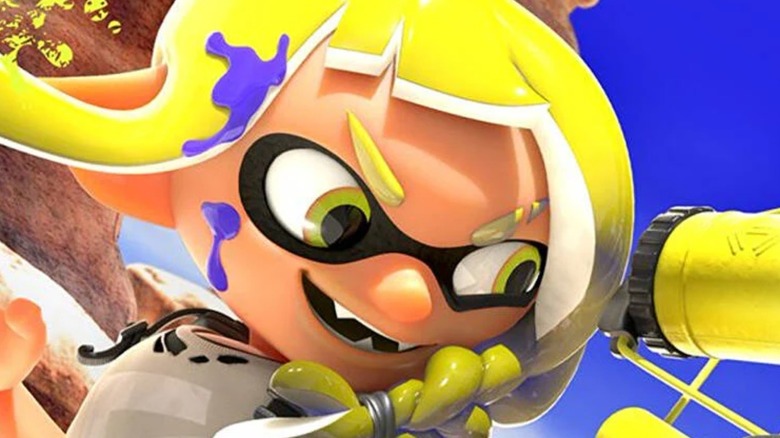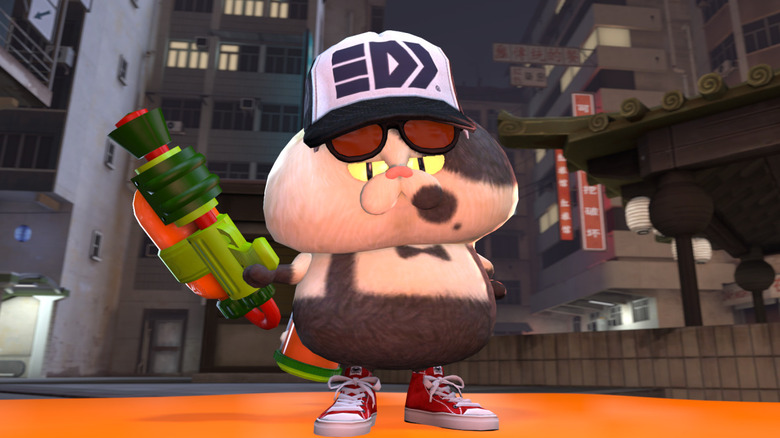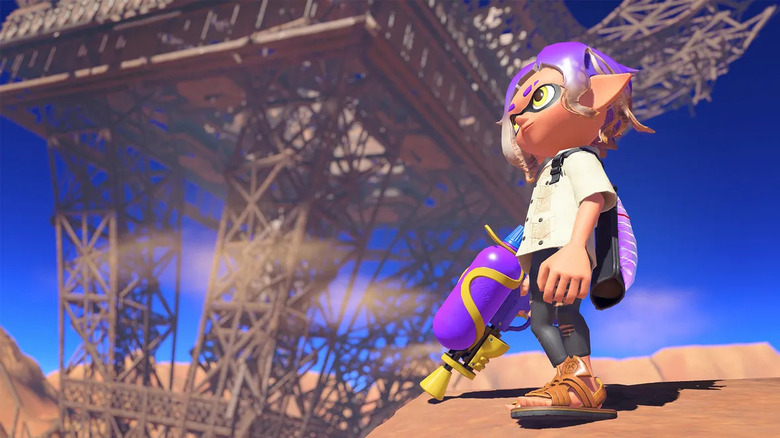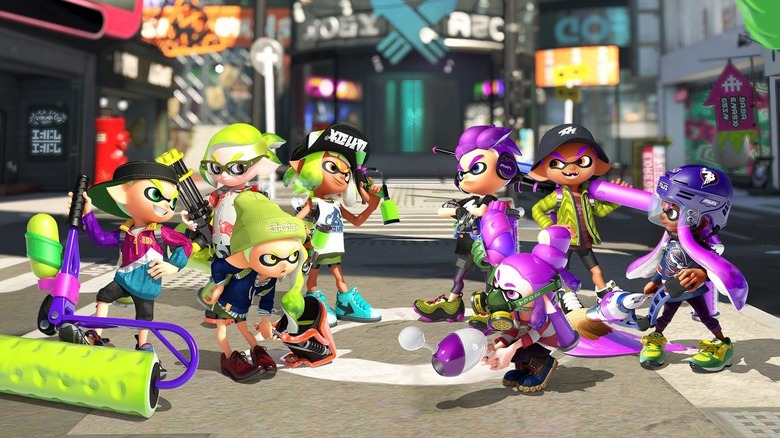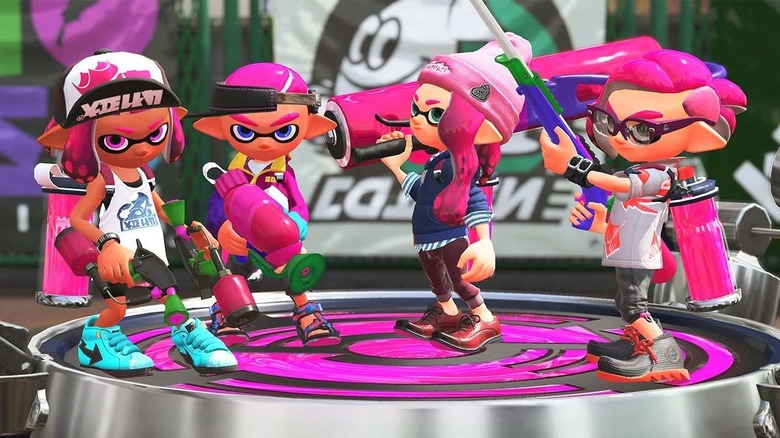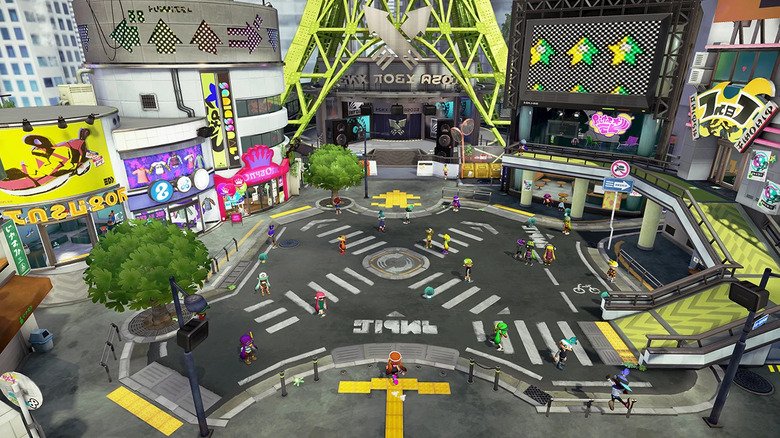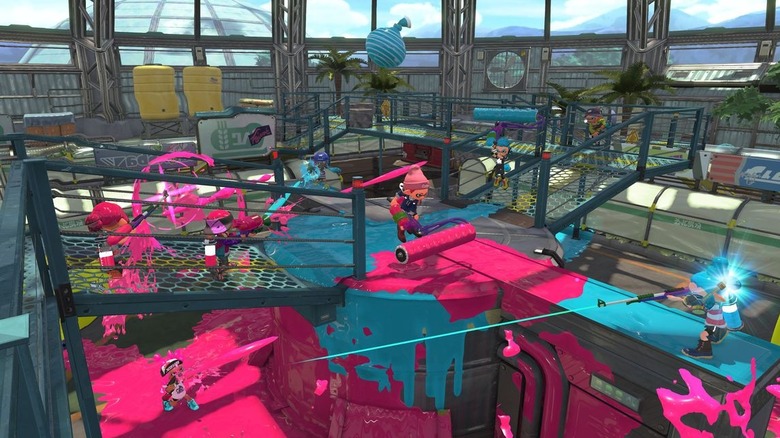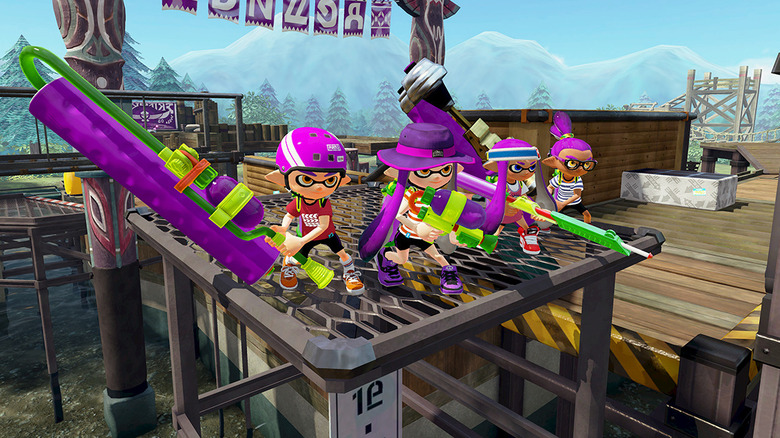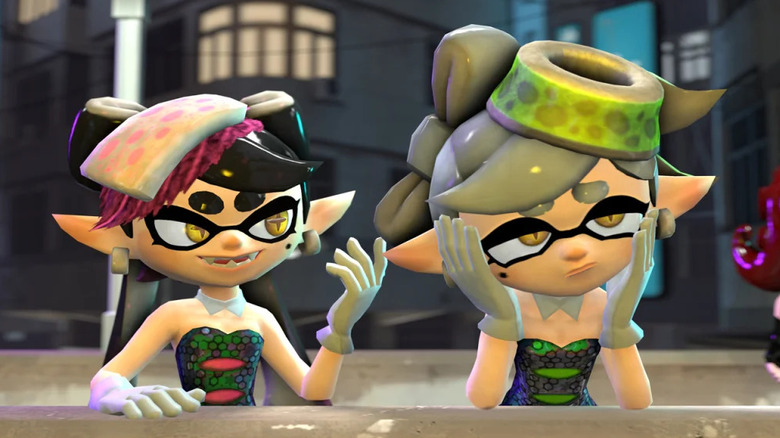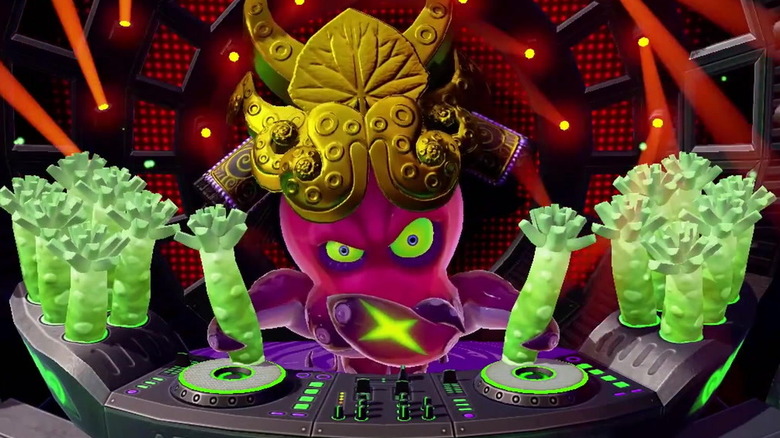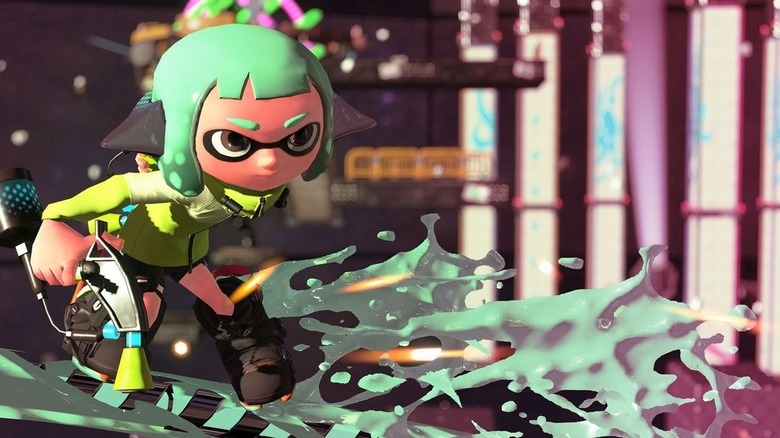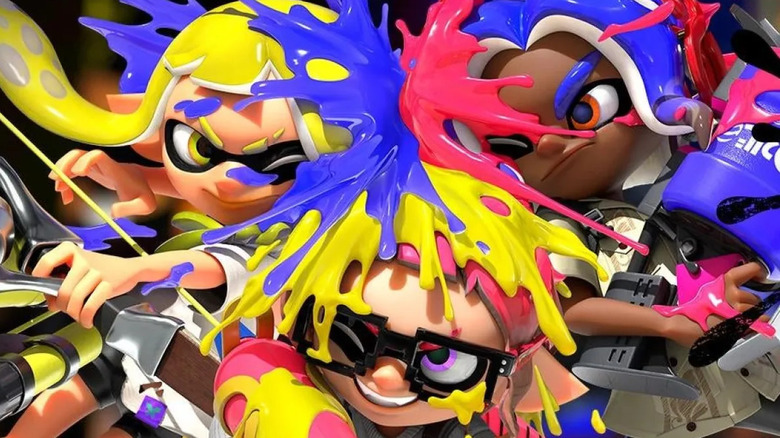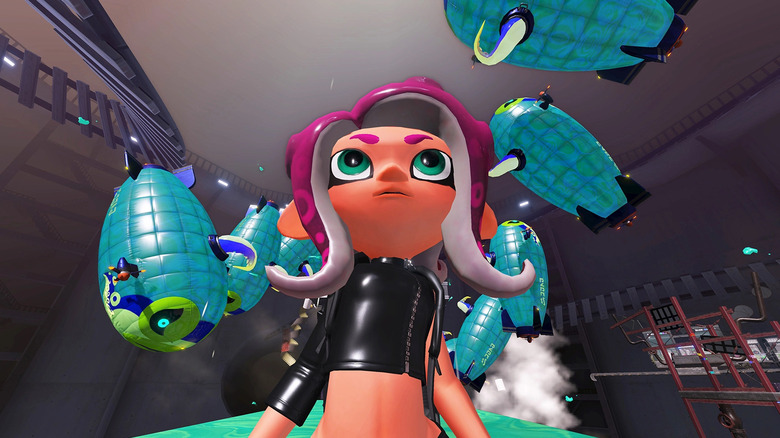The Entire Splatoon Timeline Explained
On its surface, "Splatoon" is Nintendo's family-friendly take on a multiplayer shooter. Rather than shooting bullets, players spew paint out of super soakers. Instead of focusing on killing other players, matches are won by whichever team has the highest percentage of a map covered in its ink. It also features a fun and cartoony graphical style that makes it more appealing to players of all ages. Whether players are trying to climb up the competitive ladder or are taking place in a debate of whether ketchup or mustard is better, the game features all levels of play.
However, fans may also be surprised to learn just how dark and complicated the story behind the game's setting really is. Both "Splatoon" titles currently released have single player campaigns that have their own narratives, but they are very light on story and don't delve too deeply into the dark origins of Inkling society and the origins of turf wars. So, if you are a "Splatoon" player that is interested in learning about where the Inkopolis came from or why Inklings can't get along with Octolings, here is everything you need to know about the timeline of "Splatoon."
Judd's Surprising Origins
Judd is an immediately identifiable character for "Splatoon" players. He is a very round cat that acts as the referee of the multiplayer match turf wars. However, some players may have questions when it comes to why Judd is the only mammal they can find in the first "Splatoon." Sunken scrolls found throughout the games' single player campaign peel back the curtain on the character's origins, all the way back at the start of the series' timeline. This places Judd's birth around 12,000 years before the start of the first "Splatoon."
At this time, humanity still ruled the Earth in a way similar to the real world. Shortly after Judd was born, a human scientist developed a technology that could cryogenically freeze living organisms, extending their lives for thousands of years. It is not clear why, but Judd eventually found his way into one of these cryogenic capsules alongside a computer known as a Telephone called Tartar. On Tartar, humanity stored all of its knowledge in case of its untimely distraction. This explains why Judd managed to survive thousands of years until the events of the first game, but there is still a lot of theorizing and debate amongst fans over just how old Judd is or how he has managed to survive so long after getting unfrozen.
The End of Humanity
Shortly after Judd was frozen, humanity was driven to extinction. It is known for sure that the species was killed by rising water levels that flooded all land across the planet. The rising waters killed all of the animals and plant life throughout the world. The rising waters were caused in part by humanity ignoring global warming as well as nuclear wars carried out by panicking nations. Antarctica ended up getting hit with a nuclear bomb during the wars, causing a final surge of melted ice that rose the water levels around the planet, sealing its fate.
Despite the bits of information that have been revealed about the end of the world in "Splatoon" fans still have extensive discussions considering just how the sea levels could rise enough to wipe out all animals and plant life across the entire planet. Regardless of the minutiae of how it happened, the fact remains that the world of "Splatoon" was subject to 10,000 years of being entirely underwater, leaving the planet as an ocean for that entire period of time. Only ocean creatures are known to have been active during that time and there has been no evidence found of any intelligent life. That is, until around 2,000 years before the first "Splatoon."
New Life
While all life on the land was exterminated for those 10,000 years, creatures in the oceans were able to flourish. As the oceans expanded, they were filled with new resources and allowed ocean life to blossom and expand. Over the years they took advantage of the new space and resources to expand and eventually evolve. Around 2,000 years before the start of the series the water started to recede, revealing some of the land that had been covered. This allowed some of the aquatic species to evolve to claim the land for themselves.
The main two species that arose from this were the Inklings and Octolings. Both the species took on similar appearances that were highly reminiscent of the humans they were replacing. They both took on humanoid bodies, with their previous tentacles taking the place of human hair. As they both started expanding across the land, they explored the remnants of human civilization that managed to survive the flooding. With all of the land available to the two factions, they were able to live in relative peace by staying away from one another and keeping to themselves.
The Mollusc Era
As the Octolings and Inklings started continued to grow across the land, they entered a period of time known as the Mollusc Era. This period lasted 1,900 years and saw the two races unlocking the secrets of human civilization and incorporating it into their growing society. This was made possible through the Inkling's discovery of Zapfish. Zapfish are yellow creatures roughly the size of an Inkling's head that produce and dispense electrical currents. These allowed the Inklings to power up the cities of humanity, including the cryogenic capsules they left behind.
Opening the cryogenic capsules led to an explosion of technological advancement that allowed the Inklings to develop ink-based weaponry and begin founding cities. The opening of the capsules also released both the telephone Tartar that held the knowledge of humanity and Judd into the new world. Judd then led the Inklings and Octolings in creating the Turf Wars as a competitive sport between the two of them. Not much is known about this version of the Turf Wars, but the games allude to the fact that it worked similarly to the Turf Wars players are now familiar with.
Borders are Drawn
Shortly after the Inklings unlocked the secrets of humanity, they began establishing the cities that would act as the center of their civilization. The first and biggest of these was Inkopolis, a sprawling metropolis that acts as the main location of both "Splatoon" and "Splatoon 2." While the location of Inkopolis in the world is never definitively stated, fans have pointed out that it shares numerous similarities with Tokyo. Not only is the city's main tower highly reminiscent of Tokyo Tower, but it also features statues of Tanuki and Kitsune, which are both derived from Japanese mythology.
The Inklings also founded Calamari County at this time, forming a small settlement outside of Inkopolis. The location is never shown in the games but plays into the origins of the Squid Sisters and Cap'n Cuttlefish. The creation of Inkopolis and Calamari County also started growing a division between the Inklings and Octolings. The Octolings grew jealous of the Inklings' civilization and power, as well as their drive to continue expanding and taking more of the sparse land for themselves. However, the Octolings were still capable of developing their own advanced technologies that soon started outpacing those of the Inklings.
The Great Turf Wars
Tensions between the Inklings and Octolings reached a peak around 100 years before the first "Splatoon" around the time that Cap'n Cuttlefish and DJ Octavio were both born. The two quickly rose to leadership roles within the Inklings and Octolings respectively. Quickly afterward, however, the sea levels across the planet began rising again, restricting the amount of dry land available. This restricted the room that the Inklings and Octolings had to split between them, leading to conflicts between the two groups that became known as the Great Turf Wars.
The wars were largely reminiscent of the competitive turf wars of old, but with the land claimed being kept. The Great Turf Wars lasted just over a year, and for most of its duration they were largely won by the Octolings thanks to new weapons they designed known as Great Octoweapons. The new weapons had a fatal flaw, however, in that they had a plug that could be pulled out, rendering them useless. This allowed the Inklings to completely disable the Octolings during battles, allowing them to push all of the Octolings in a small area of land that came to be known as Octo Valley.
The Rise of Splatoon
After the end of the Great Turf War, turf wars went back to becoming a popular competitive sport. The sport experienced a meteoric rise that saw it sweeping throughout Inkling life to end up largely defining the entire culture. This allowed Inkopolis to thrive and expand even more around new brands and industries that rose around the sport. From developing new weapons to sponsoring teams, organizing competitions, and building arenas for matches. As Inkopolis managed to spread turf wars became more and more influential among Inklings.
The popularity of turf wars was also supported by all of the Inklings with combat training from fighting the Octolings that were looking for a way to use the skills they picked up. The sport becoming so popular also provided a method for Inklings to stay ready for combat in case of a return of the Octolings or their leader DJ Octavio. That is why the center of Inkopolis that players see is almost entirely dedicated to supporting turf wars and those who participate in them.
The Idols
Around the same time that turf wars begin rising in Inkling culture, Inklings also supported the rise of pop idols. This started with a first annual folk musical competition in Calamari County. This led to the discovery of the Squid Sisters, Pearl Houzuki, and Marina Ida. The Squid Sisters experienced the most significant rise in popularity and became the biggest faces of the turf wars. Some even think the pair might be dating. They also have a very close relationship with the likes of Cap'n Cuttlefish, who they worked with in an effort to prevent any retaliatory strikes from the Octolings.
That perspective was not shared by all of the idols, as Marina Ida was publicly recognized as speaking out against what she called the oppression of the Octolings. She was an Octoling herself, and had to work as an engineer in their army during the Great Turf Wars when she was just a child. She only left the Octolings when she heard the Squid Sisters perform and became determined to become an idol just like them. So, she teamed up with Pearl and the two won their own musical competition in Calamari County before rising to fame and replacing the Squid Sisters, introducing players in "Splatoon 2."
DJ Octavio's Revenge
The main story mode of "Splatoon" is called Octo Valley and centers around a revenge plot from DJ Octavio. The story mode sees the player's Inkling joining forces with Cap'n Cuttlefish and the Squid Sisters to found a special operation group known as the Squidbeak Splatoon. The group is formed after the Great Zapfish that powers all of Inkopolis is stolen, throwing the city into a crisis. The player character, dubbed Agent 3 after joining the Squidbeak Splatoon, is then tasked with tracking down the Great Zapfish and returning it safely to the city.
During the investigation Agent 3 discovers that the Great Zapfish was stolen by none other than DJ Octavio himself. With it, Octavio planned to create newer and more powerful weapons to take revenge on the Inklings that banished his people to the Octo Valley. However, Agent 3 sabotages Octavio's efforts by attacking Octo Valley to try and locate the Great Zapfish and destroy their new weapons. DJ Octavio responded by kidnapping Cap'n Cuttlefish to try and disband the Squidbeak Splatoon. However, Agent 3 and the Squid Sisters teamed up to rescue Cap'n Cuttlefish and defeat DJ Octavio during a concert he was holding.
Between Games
A few years passed between "Splatoon" and "Splatoon 2" and in that time some key changes occurred around Inkopolis to set up the sequel. Perhaps the most significant of these was the arrival of Salmonids. Salmonids are mutated fish that appeared in the sea near Inkopolis. The sea around the city is so irradiated that most creatures cannot survive in it, but the Salmonids were found to thrive in the dangerous ecosystem. They quickly became a problem for the Inklings, as hordes of Salmonids started periodically scouring the nearby land to steal technology and resources to put toward building their own civilization.
The issue led to the founding of a company called Grizzco Industries by Mr. Grizz. The company began hiring Inklings, and eventually Octolings, to fend off Salmonids while also collecting golden eggs of theirs to study. This allowed Grizzco Industries to learn more about the Salmonids than ever before while also helping protect Inkopolis from the growing threat. They also are at the center of the Salmon Runs game mode that was introduced in "Splatoon 2" and sees four players teaming up to fight waves of Salmonids.
Splatoon 2
When "Splatoon 2" released, it launched with a single player campaign mode called Octo Canyon. The story of this mode begins with the Squid Sister Marie discovering that Cap'n Cuttlefish in Calamari County is abandoned. Then, players discover that DJ Octavio escaped from the snow globe he was imprisoned in after being defeated at the end of "Splatoon." Shortly after Marie left to investigate what was happening the Great Zapfish was stolen yet again. To help her retrieve the Great Zapfish, Marie recruits a new character, Sheldon, and welcomes the player's character into the Squidbeak Splatoon as Agent 5 and Agent 4 respectively.
The two of them embark on multiple missions to track down DJ Octavio and eventually discover that the other Squid Sister Callie has fallen under the brainwashing influence of Octavio. Agent 4 then teams up with Marie to free Callie from Octavio's control. Marie and Callie are then reunited to perform a song that helps Agent 4 defeat DJ Octavio yet again. Once he is defeated the Great Zapfish is returned to Inkopolis yet again and DJ Octavio explodes, potentially implying that he was defeated for good.
Octo Expansion
The Octo Expansion for "Splatoon 2" added a new story campaign to the game and continued the series' conflict between the Inklings and Octolings. The expansion's story begins with Agent 3 from "Splatoon" facing off against one of the last known Octolings. The Octoling lost their memory from the battle and became known as Agent 8 within the Squidbeak Splatoon. Agent 8 then teams up with Cap'n Cuttlefish to try and locate Agent 3 after they are mysteriously kidnapped. While investigating the occurrence Agent 8 finds a Telephone that offers to help them and Cuttlefish.
The Telephone orders Agent 8 to collect four powerful artifacts known as Thangs, but once they do it is revealed that the Telephone is Tartar, the original one created by the human scientists thousands of years ago. Tartar then reveals that over the years he has become disgusted by the constant squabbles between the Inklings and Octarians. So, he devised a plot to create an even more powerful breed of Octarians that would be able to wipe them both out and rebuild the world in Tartar's image. Agent 8 then teams up with Agent 3 and the rest of the Squadbeak Splatoon to defeat Tartar and return things to normalcy.

